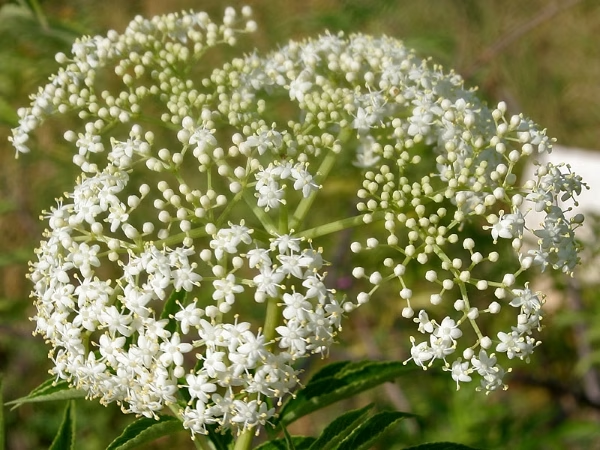
Common Elderberry
Botanical Name
:
Sambucus canadensis
Plant Type
:
Deciduous shrub
Seasons
:
Plant in fall or spring; blooms in spring and summer
Sun Level
:
Full sun to partial shade (4–6+ hours of sunlight)
Ideal Soil Temperature for Planting
:
60–75°F (15–24°C)
Soil Type
:
Moist, well-draining soil; tolerates clay, loam, and sandy soils
Hardiness Zones
:
3–9 (USDA)
Germination
:
Seeds require cold stratification (60–90 days)
P.H. Level
:
5.5–6.5 (slightly acidic to neutral)
Water/Irrigation
:
Water regularly, especially during the first year to establish roots. Mature plants are somewhat drought-tolerant but benefit from supplemental watering during dry periods, especially when fruiting
Fertilization
:
Benefits from organic mulch and balanced fertilizer in early spring
Habit
:
Upright, multi-stemmed, spreading shrub
Propagation
:
Can be propagated by seeds, cuttings, or suckers
Final Plant Height
:
5–12 ft
Spread
:
5–10 ft
Flowers
:
Creamy white, fragrant, flat-topped clusters (May-June)
Attracts
:
Bees, butterflies, hummingbirds, and other pollinators
Uses
:
Edible berries (used in jams, jellies, syrups, and wines), ornamental landscaping, erosion control and wildlife habitat, traditional medicinal applications
Companions
:
Wildflowers, native grasses, other shrubs like serviceberry (Amelanchier), and viburnum
Pruning
:
Prune in late winter or early spring to remove dead/diseased wood and encourage new growth
Toxicity
:
Raw berries, stems, leaves, and roots contain cyanogenic glycosides, which can be toxic if consumed in large quantities. Cooked berries are generally safe
Pests
:
Aphids, elderberry borers, Japanese beetles, spider mites
Diseases
:
Canker, powdery mildew, and leaf spot can occur
Fun Fact
:
Native Americans and early settlers used elderberry flowers and berries for medicinal teas and remedies
Botanical Name
:
Sambucus canadensis
Plant Type
:
Deciduous shrub
Seasons
:
Plant in fall or spring; blooms in spring and summer
Sun Level
:
Full sun to partial shade (4–6+ hours of sunlight)
Ideal Soil Temperature for Planting
:
60–75°F (15–24°C)
Soil Type
:
Moist, well-draining soil; tolerates clay, loam, and sandy soils
Hardiness Zones
:
3–9 (USDA)
Germination
:
Seeds require cold stratification (60–90 days)
P.H. Level
:
5.5–6.5 (slightly acidic to neutral)
Water/Irrigation
:
Water regularly, especially during the first year to establish roots. Mature plants are somewhat drought-tolerant but benefit from supplemental watering during dry periods, especially when fruiting
Fertilization
:
Benefits from organic mulch and balanced fertilizer in early spring
Habit
:
Upright, multi-stemmed, spreading shrub
Propagation
:
Can be propagated by seeds, cuttings, or suckers
Final Plant Height
:
5–12 ft
Spread
:
5–10 ft
Flowers
:
Creamy white, fragrant, flat-topped clusters (May-June)
Attracts
:
Bees, butterflies, hummingbirds, and other pollinators
Uses
:
Edible berries (used in jams, jellies, syrups, and wines), ornamental landscaping, erosion control and wildlife habitat, traditional medicinal applications
Companions
:
Wildflowers, native grasses, other shrubs like serviceberry (Amelanchier), and viburnum
Pruning
:
Prune in late winter or early spring to remove dead/diseased wood and encourage new growth
Toxicity
:
Raw berries, stems, leaves, and roots contain cyanogenic glycosides, which can be toxic if consumed in large quantities. Cooked berries are generally safe
Pests
:
Aphids, elderberry borers, Japanese beetles, spider mites
Diseases
:
Canker, powdery mildew, and leaf spot can occur
Fun Fact
:
Native Americans and early settlers used elderberry flowers and berries for medicinal teas and remedies
Written by Nondiah Khalayi – https://www.linkedin.com/in/nondiah-khalayi/

